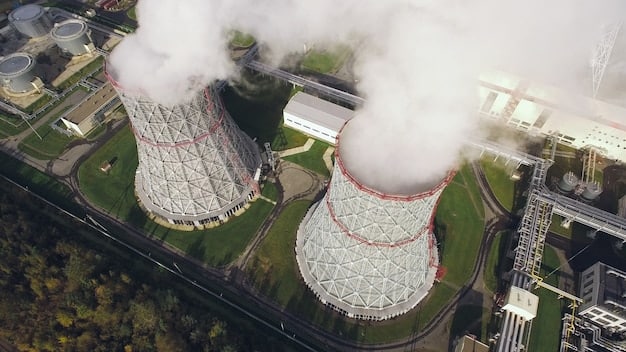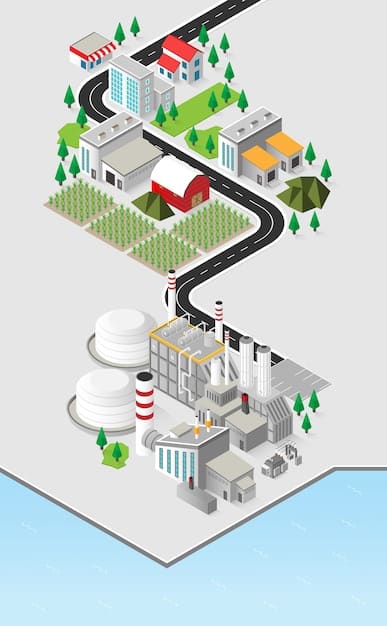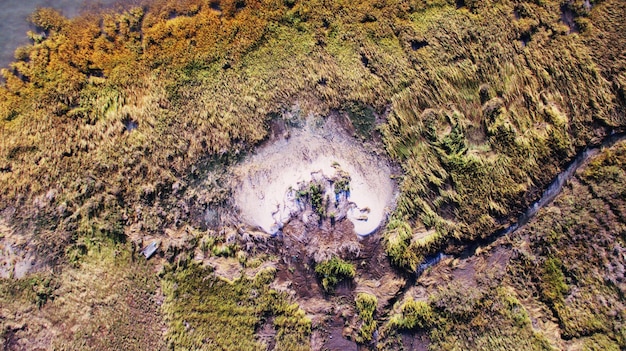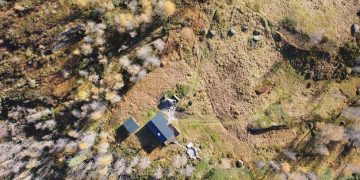Navigating US Carbon Capture Tax Credits: A Guide for Businesses

Navigating the complexities of the new US carbon capture tax credits to maximize financial benefits requires businesses to understand eligibility criteria, project planning, and compliance reporting, allowing them to leverage incentives for carbon capture, utilization, and storage (CCUS) projects effectively.
The US government has introduced significant carbon capture tax credits to encourage businesses to invest in technologies that reduce carbon emissions. How can businesses navigate the complexities of the new US carbon capture tax credits to maximize financial benefits? This article provides a comprehensive guide to understanding and leveraging these incentives for carbon capture, utilization, and storage (CCUS) projects.
Understanding Carbon Capture Tax Credits
Carbon capture tax credits, particularly the enhanced 45Q tax credit, are designed to incentivize businesses to invest in carbon capture projects. These credits provide financial benefits for capturing and storing carbon dioxide (CO2) emissions, promoting the deployment of carbon capture technologies across various industries.
Overview of the 45Q Tax Credit
The 45Q tax credit is a federal incentive that rewards businesses for capturing CO2 and either storing it permanently or using it for enhanced oil recovery (EOR) or other qualified purposes. The credit aims to reduce greenhouse gas emissions by making carbon capture projects more economically viable.
Key Components of the 45Q Tax Credit
To fully understand the 45Q tax credit, you should grasp several key components, including eligibility requirements, credit amounts, and the types of projects that qualify. Specifically, the eligibility criteria includes details about the amount of carbon captured, the methods of storage or utilization, and the types of facilities that can qualify.
- Eligibility Criteria: Projects must capture CO2 from qualified facilities, with specific requirements for the amount of CO2 captured and the methods of storage or utilization.
- Credit Amounts: The amount of the credit varies depending on whether the CO2 is stored geologically or used for EOR, with higher credits available for secure geological storage.
- Qualified Facilities: These include industrial facilities and direct air capture (DAC) projects that meet certain emissions thresholds and capture requirements.
By understanding these components, businesses can better assess the potential financial benefits of implementing carbon capture projects and take advantage of the available incentives.

The 45Q tax credit is a tool that can significantly offset the capital investments associated with carbon capture technologies, making these projects more feasible for companies across industries. Properly grasping its essential facets makes these projects more accessible and economically attractive.
Assessing Project Eligibility
Determining whether a carbon capture project is eligible for tax credits involves a thorough assessment of several factors, including the type of facility, the amount of CO2 captured, and the intended use or storage of the captured carbon. To assess project eligibility for carbon capture tax credits, businesses must consider various factors to ensure their projects meet the necessary criteria.
Types of Qualified Facilities
Qualified facilities include industrial facilities that emit CO2 as a byproduct of their operations, as well as direct air capture (DAC) projects. These facilities must meet specific emissions thresholds and capture requirements to be eligible for the 45Q tax credit.
Minimum Capture Requirements
To qualify for the 45Q tax credit, projects must capture a minimum amount of CO2 annually. The specific amounts vary depending on the type of facility: industrial facilities and power plants have specific thresholds set, while DAC facilities have a lower minimum due to the nature of their operations.
Ensuring Compliance and Verification
To maximize financial benefits, businesses must develop a detailed project plan that outlines the carbon capture process, storage methods, and compliance reporting procedures. Additionally, the importance of verification methods involves implementing systems to accurately measure and verify the amount of CO2 captured and stored, with third-party validation further ensuring compliance.
- Detailed Project Plan: Outlines the carbon capture process, storage methods, and compliance reporting procedures.
- Verification Methods: Implement systems to accurately measure and verify the amount of CO2 captured and stored.
- Third-Party Validation: Obtain validation from independent experts to ensure compliance and maximize credit eligibility.
By ensuring compliance and verification, businesses can maximize the value of their carbon capture projects and contribute to a more sustainable future.

Assessing a project’s eligibility is the first step toward potentially securing valuable tax credits. Fully understanding the distinct criteria can improve a company’s chances of not only regulatory compliance, but also of maximizing financial returns.
Maximizing Financial Benefits
Once a project is deemed eligible, the next step is to maximize the financial benefits available through carbon capture tax credits. This involves careful planning, strategic partnerships, and ongoing monitoring and reporting.
Understanding Credit Calculation
The 45Q tax credit offers different credit amounts based on storage or utilization methods on whether the CO2 is stored geologically or used for EOR. There are higher credits available for secure geological storage, as well as incentives for beneficial utilization, such as using captured CO2 to produce valuable products.
Strategic Partnerships and Financing
To execute carbon capture projects effectively, forming strategic alliances can bring expertise, boost investment and innovation, and lower risks. These can also help with optimizing the financial structure to maximize the value of the credits.
Monitoring and Reporting
To maximize the financial benefits, businesses must monitor and report on project data, using accurate measuring and reporting methods, and ensuring credit monetization strategies. Accurate data ensures the business qualifies for the maximum accessible credit, while strategic tactics can increase the financial gains from these tax credits.
Implementing robust monitoring and reporting procedures is crucial for ensuring compliance and maximizing the financial benefits of carbon capture projects.
Maximizing the financial benefits requires continuous attention to detail and strategic decision-making. By understanding data monitoring and reporting and staying up-to-date with policy developments, companies can make better-informed, strategic choices that bolster financial returns and environmental obligations.
Navigating Regulatory Challenges
Navigating the regulatory landscape is a critical aspect of leveraging carbon capture tax credits. Compliance with environmental regulations and adherence to reporting guidelines are essential for maximizing financial incentives and avoiding penalties.
Environmental Regulations
Carbon capture projects must comply with a range of environmental regulations at the federal, state, and local levels. These regulations cover aspects such as air quality, water resources, and waste management. Compliance with environmental regulations is essential for ensuring the sustainability and responsible operation of carbon capture projects.
Reporting Requirements
Accurate and timely reporting is crucial for claiming carbon capture tax credits. Businesses must adhere to specific reporting requirements set forth by the IRS, including detailed information about the amount of CO2 captured, the methods of storage or utilization, and the project’s overall environmental impact.
- IRS Guidelines: Follow detailed instructions for claiming the 45Q tax credit.
- Documentation: Maintain thorough records of all carbon capture and storage activities.
- Audits: Be prepared for potential audits by regulatory agencies.
Meeting compliance requirements requires businesses to maintain detailed records, adhere to standardized reporting formats, and undergo regular audits to ensure accuracy and transparency.
A proactive approach to regulatory problems can result in better environmental performance and economic efficiencies. By successfully navigating these compliance procedures and adhering to environmental norms, firms can ensure the long-term sustainability and profitability of their carbon capture activities.
Future Trends and Policy Updates
The landscape of carbon capture tax credits is continuously evolving, with new policies and technological advancements shaping the future of the industry. Staying informed about these trends is essential for businesses looking to invest in carbon capture projects, as it helps them plan effectively and maximize the value of available incentives.
Emerging Technologies in Carbon Capture
Innovations such as direct air capture (DAC) and advancements in storage and utilization methods are enhancing the efficiency and cost-effectiveness of carbon capture technologies. Ongoing research aims to lower the costs associated with carbon capture and improve its scalability across various industries.
Potential Policy Changes
Government support and potential changes in tax credit policies can significantly impact the economic viability of carbon capture projects. Businesses should monitor policy updates to adapt their strategies and take advantage of new opportunities.
Preparing for the Future
To stay ahead in the carbon capture industry, businesses should proactively plan for future trends. This includes forming strategic partnerships and collaborations, continuous improvements via technological innovation, and developing flexible financial models.
Staying informed about future trends and policy updates is essential for businesses aiming to navigate the evolving landscape of carbon capture tax credits and effectively leverage these incentives for sustainable growth.
Case Studies: Successful Implementation
Examining successful carbon capture projects and initiatives can provide valuable insights and best practices for businesses looking to implement similar projects. These case studies highlight the benefits of carbon capture technologies and the effective utilization of tax credits.
Case Study 1: Industrial Facility
An industrial facility captures CO2 from its manufacturing processes and stores it geologically. This project demonstrates the application of carbon capture in reducing emissions from industrial sources and the effective use of 45Q tax credits to offset project costs.
Case Study 2: Direct Air Capture Project
A direct air capture (DAC) project captures CO2 directly from the atmosphere and uses it to produce valuable products. This case study illustrates the potential of DAC technology in mitigating climate change and the financial benefits of utilizing captured CO2.
- Project Planning: Develop a comprehensive plan that aligns with business goals and regulatory requirements.
- Technology Selection: Choose the most appropriate technology based on project specifics and cost-effectiveness.
- Stakeholder Engagement: Foster collaboration with stakeholders, including government agencies, communities, and industry partners.
Examining real-world examples provides insights into best practices and successful strategies, helping businesses implement effective and lucrative carbon capture projects.
By examining these scenarios, companies can gain real insights into the best strategies for successful carbon capture projects and fully utilizing available tax breaks. These types of case studies offer a roadmap for companies attempting to achieve both sustainability objectives and financial gains.
| Key Aspect | Brief Description |
|---|---|
| ✅ Eligibility | Meeting requirements for facility type and CO2 capture. |
| 💰 Financial Benefits | Understanding credit calculation and strategic partnerships. |
| 📜 Compliance | Adhering to environmental and reporting regulations. |
| 📈 Future Trends | Staying updated on technology and policy developments. |
Frequently Asked Questions
▼
The 45Q tax credit is a US federal incentive that rewards businesses for capturing carbon dioxide (CO2) and either storing it permanently or using it for enhanced oil recovery or other qualified purposes.
▼
Eligible parties include those who physically capture and ensure qualified storage or utilization of CO2. It applies to various industries, including manufacturing plants and direct air capture facilities.
▼
Credit amounts depend on the method of CO2 disposal – geological storage or enhanced oil recovery – and the amount of CO2 captured annually. Higher credits are available for secure geological storage.
▼
Key requirements include adhering to EPA and IRS regulatory guidance, maintaining detailed records, and verifying CO2 capture and storage through approved measurement and reporting methods.
▼
Businesses can stay informed by monitoring official IRS and EPA communications, consulting with tax and compliance professionals, and participating in industry-specific conferences and webinars.
Conclusion
Navigating the complexities of US carbon capture tax credits presents a significant opportunity for businesses to reduce their carbon footprint while maximizing financial benefits. By understanding the eligibility criteria, project planning requirements, and compliance reporting procedures, companies can successfully leverage these incentives for carbon capture, utilization, and storage projects.





